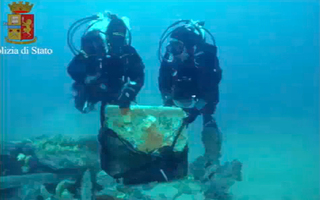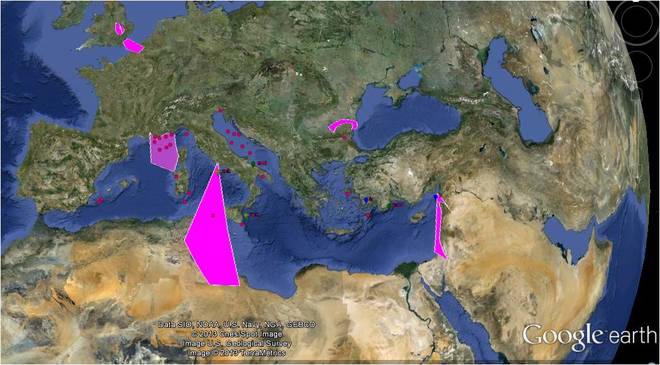
http://www.telegraph.co.uk/news/worldnews/europe/italy/11693734/Well-preserved-ancient-Roman-ship-found-in-waters-off-Sardinia-coast.html
The report has some nice photos – Especially gratifying is the photograph of two divers lifting a single tile off the sea bed:

Which shows just what a non trivial task load up a cargo of a roofs worth of roof tile onto a ship would be.
The @rogueclassism twitter feed expressed surprised at tie cargios, so I thought I may drag out the evidence I used for my Thesis (http://www.archaeopress.com/archaeopressshop/public/displayProductDetail.asp?id={C5CE327D-710F-44D9-AC3A-7C04BC75D091})
The first place to start when looking for tile wreck data is Parkers gazateer on ship wrecks: Parker A.J.1992 Ancient Shipwrecks of the Mediterranean and the Roman Provinces BAR IS
Below I have plotted out all the find spots of Roman wrecks with cargo as a primary cargo ( as opposed used in the ships galley etc).
We can see that the ship wrecks do cluster somewhat ( remembering that this was compiled in 1992 so before deep sea wreck hunting was really possible) I have shaded in areas where we can establish regional tile trading zones: The Northern Levant and the Orontes being supplied from Cilicia, the supply line along the Danube ( certainly in Bulgaria – probably somewhat wider) the trade in Campagnian roof tile and brick to North Africa, the cluster identified by Parker as related to Frejus in France. I have a couple of additional zones outside the Mediterranean: the classis Britannia bricks that have been identified by David Peacock as appearing on both sides of the channel, the late Roman pink grog tempered zone in Britain ( which is interesting as this would have to be transported over land). There are a number of other regional CBM zones in Britain that are beginning to emerge as I get to see them (Mills, P The Supply and Distribution of Ceramic Building Material In Roman Britain, Late Antique Archaeology 10., 451-470. http://www.brill.com/products/book/local-economies ) There are a number of barges inland in Belgium and the Netherlands which were carrying tiles known as well – but not plotted here.
We can also see something of a cluster in the Adriatic sea - - I’m not aware of any work there to determine if they are part of a trading zone, but it looks like there is one there.
Coming to Sardinia we can see a few points already on the map – if the tiles are from Italy as suggested than I will have to extend that trading zone next time I produce this map.
To put the number of tile wrecks into context – some 4% of the cargos listed in Parker are tile cargos ( compared to 2% of stone cargos). To my mind this is a lot.
So why this long distance transport of tile. The most common model was that these are ‘ballast cargoes’ – ships that are coming from Italy to pick up grain for the annona which would otherwise be empty. Obviously this model takes a battering given how widespread regional trades are, outside the areas of the annona ( e.g. tiles to Beirut are perhaps going the wrong way). As the photos of the divers conveys, manufacturing the tiles, transporting them to a ship then loading them, unloading them and transporting them to a building site are not trivial tasks – you also need to have specialist who know how to roof a building. This ultimately is part of my argument that Roman roof tiles should be considered as high cost high status items ( of which more perhaps later)

 RSS Feed
RSS Feed
